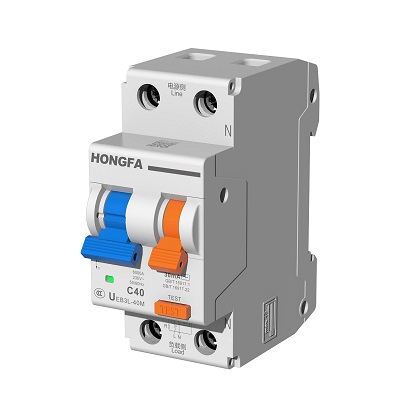Low-voltage electrical appliances, as an indispensable part of the power system, play a vital role. They are extensively applied in civil, commercial, and industrial sectors since they offer consistent and safe energy source for many kinds of machinery. Low-voltage electrical appliances in the power system are like blood vessels and nerves in the human body, distributing electrical energy to every point of contact to guarantee equipment normal operation. Apart from their transfer of electrical energy, they also perform protective and controlling roles for it.This article examines the selection principles of thermal relays and circuit breakers.

Residual Current Circuit Breaker 2 Pole
In industrial production, low-voltage electrical appliances are key components on automated production lines. To raise production efficiency, they precisely control the start and stop, speed and direction of equipment. Low-voltage electrical appliances guarantee the normal operation of lighting, air conditioning and other equipment in shopping malls, office buildings and other venues, thereby giving people a comfortable surroundings in the commercial sector. Low-voltage electrical equipment have direct bearing on people’s daily life in the civic domain. For instance, it is impossible to separate the support of home appliances including TVs, refrigerators, etc. from their usage. What thus are the low-voltage electrical appliance selection criteria? It is introduced to you momentarily in the following article.
01 Selection of thermal relays
The thermal relay’s tripping value for non-operating current is 1.05 In and for operating current is 1.2 In. It is built in line with motor overload characteristics. Thus, the current adjustment range of a thermal relay can satisfy the rated current of the motor when choosing one.
Second, whether the motor is light-loaded or heavy-loaded will determine the tripping level of the thermal relay to be chosen. Generally, it is divided into 10A 10 20 30 levels, which correspond to the tripping time of the thermal relay under 7.2 In (under the condition of ambient temperature of 20 degrees). For water pump loads, for instance, 10A level is applied for light-load starts. Starting a fan load from 20 level is heavy-load oriented.
02 Principles for selecting circuit breakers
1. Plastic case circuit breaker – broad guidelines for choosing circuit breakers
(1) The rated working voltage of the circuit breaker ≥ the rated voltage of the line.
(2) The rated current of the circuit breaker ≥ the load current of the line.
(3) The rated short-circuit breaking capacity of the circuit breaker ≥ the maximum short-circuit current that may occur in the line (calculated as effective value).
(4) The single-phase short-circuit current at the line’s end > 1.25 times the circuit breaker instantaneous release current.
(5) The rated voltage of the circuit breaker’s undervoltage release = the rated voltage of the line.
(6) The rated voltage of the circuit breaker’s shunt release = the control power supply voltage.
(7) The rated working voltage of the electric transmission machine = the control power supply voltage.
(8) Verify the wiring direction the circuit breaker lets you use. While some versions of circuit breakers just let top access, others let top or bottom entry.
2. Selection principles for circuit breakers for power distribution
(1) The long-delay action current setting value of the circuit breaker ≤ the allowable current carrying capacity of the conductor. In the case of using wires and cables, 80% of the allowable current carrying capacity of the wires and cables can be taken.
(2) The return time of 3 times the long-delay action current setting value ≥ the starting time of the motor with the maximum starting current in the line.
(3) Instantaneous current setting value ≥ 1.1X (Ijx + k1kIedm)
IJx————Line calculated load current;
k1————Motor starting current impact coefficient, generally k1=1.7-2;
k————Motor starting current multiple;
Icdm————Rated current of the largest motor
3. Selection principles of motor protection circuit breakers
(1) Long delay current setting value = motor rated current
(2) Instantaneous setting current: For circuit breakers protecting cage motors, instantaneous setting current = (8-15) times motor rated current; For circuit breakers protecting wound rotor motors, instantaneous setting current = (3-6) times motor rated current.
(3) The return time of 6 times the long delay current setting value ≥ the actual starting time of the motor. The load weight at commencement determines the return time from 1S, 3S, 5S, 8S, 12S, 15S.
03 Circuit breaker and fuse coordination
(1) If the expected short-circuit current at the installation point is less than the rated breaking capacity of the circuit breaker, a fuse can be used as backup protection because the rated short-circuit analysis capability of the fuse is strong. Characteristic 1 of the backup fuse crosses with characteristic 2 of the circuit breaker as seen in Figure 1. The shorter breaking time of the fuse when the line is short-circuited helps to guarantee the safety of the circuit breaker. One can choose at 80% of the rated short-circuit breaking capacity of the circuit breaker the junction point on the characteristics.
(2) The fuse should be installed on the power supply side of the circuit breaker to ensure safe use.

UER3 Thermal Overload Relay
04 Low-voltage circuit breaker number of poles
I don’t see any need for clarifying the idea of low-voltage circuit breaker poles here. View GB14048.1 “General Principles for Low-voltage Switchgear and Control Equipment”.
Allow me to clarify Circuit Breaker Pole Count. Usually there are two, three, and four poles; the four-pole types are A, B, C, and D:
1) A: The four-pole does not have an overcurrent release, and does not switch on and off with the other 3 poles;
2) B: The four-pole does not have an overcurrent release, and switches on and off with the other 3 poles;
3) C: The four-pole has an overcurrent release, and does not switch on and off with the other 3 poles;
4) D: The four-pole turns on and off with the other three poles; it has an overcurrent release.
Post time: 7 月-18-2024


